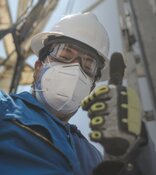TAG Oil Ltd. (TAO:TSX.V; TAOIF:OTCQX) has announced the successful first oil production in its vertical well, BED 1-7, at the Badr Oil Field (BED-1) in the Western Desert of Egypt.
The company perforated the Abu Roash F Formation (ARF) reservoir and completed a diagnostic fracture injectivity test (DFIT). In the test, TAG used "hydraulic fracture simulation," which involved the injection of fluids under high pressure into low-permeability rock underground to induce fractures and increase the rock's permeability for better oil extraction.
The fracture was simulated with 110 tons of sand treatments and a pump schedule, confirming the company's reservoir models and projected stable performance.
Bill Newman, a market analyst at Research Capital, wrote on a research note dated May 9 that they maintain a "speculative Buy" for TAG at US$1.35 per share.
The well flowed naturally to the surface, and TAG was able to recover 40% of the fracture fluid and produce over 500 oil barrels during the short flow back from the test. The reservoir was connected to a flowline to the BED 1 field's facilities onward into a sales pipeline.
An Electric Submersive Pump (ESP) was also installed in the well to help achieve steady production at stabilized oil rates.
"This activity is the first step to establish oil production from the ARF Formation, an oil-rich source rock that covers a significant portion of the 107 sq. km. BED-1 concession. Production results confirm the economic feasibility of this important resource play in the Western Desert of Egypt," Toby Pierce, CEO of TAG Oil, said.
TAG Oil is a Canada-based and listed oil and gas exploration company engaging in acquisitions, exploration, and production in the Middle East and North African (MENA) region.
The Catalyst: Stable Oil Production Potential and Horizontal Well Construction in June
The BED-1 well is expected to produce oil within the next few days. The company also expects to announce 30-day rates from the well in mid-June.
TAG Oil reported that data from its geomechanical and 3D seismic review had enhanced the design of a horizontal well, which is expected to start "spudding" or drilling in June.
With all the permits already secured and site construction now underway, the company is currently securing a drilling rig in time for the June drilling of the first horizontal well in BED-1.
Drilling for a potential second horizontal well is expected around December 2023 or January 2024.
Why TAG Oil?
Bill Newman, a market analyst at Research Capital, wrote on a research note dated May 9 that they maintain a "speculative Buy" for TAG at US$1.35 per share. This is due to the combined positive fracture simulation results, the upcoming oil sale and drilling for a horizontal well, as well as some potential risks that may arise.
Although TAG has conducted a detailed analysis of the ARF zone, Newman said there is yet to be a guarantee of the commerciality of the shale play. On the financial side, it is possible that the company might run into issues with the scaling of production and that it may need to raise additional working capital if unable to increase production. The company's hydrocarbon production is, in itself, highly speculative, with a high degree of risk for exploration failure.
Malcolm Shaw of Hydra Capital Partners views TAG favorably, given the strong initial flow back results with the early show up of oil without yet the assistance of a pump.
As an international company working out of Egypt, TAG has the risk of fluctuations in the Egyptian pound, the U.S. dollar, and the Canadian dollar, as well as the political risks of working in a foreign nation where laws can change at any time and impact the company's profitability. Egypt extensively regulates the energy industry, with influence over exploration and production activities, prices, taxes, royalties, and export restrictions.
Despite the risks, Newman said strong oil production in the next few days and the 30-day rates to be announced in mid-June could serve as a major catalyst for the stock.
Meanwhile, Malcolm Shaw of Hydra Capital Partners views TAG favorably, given the strong initial flow back results with the early show up of oil without the assistance of a pump.
Shaw said the Badr oil field has pre-existing infrastructure from Shell 40 years ago, which means lower costs and faster production, sale, and cash flow for TAG, which is unusual for international exploration.
He cited RPS estimates of 531.5 million barrels of oil in the ARF reservoir that the company can still tap using modern horizontal multi-stage fracture simulation, also known as hydraulic fracturing or fracking. Using the unconventional method that drove the "Shale revolution" in North America, the company will design a horizontal well with one or two dozen frack stages more than the single stage in a vertical test. This new technology will then result in an increase in flow rate, usually around four to eight times and sometimes higher.
Shaw said the Badr field under TAG could be the biggest fracking in the African continent.
"Assuming things go according to plan, my bet is that by Q3/Q4 of 2024, TAG could be looking at a US$500 million market cap based on the Badr asset alone (assuming it trades at half of its foreseeable NPV). Should the company add another project or two to its portfolio, things can grow beyond that," Shaw said.
"TAG pumped over 110 tons of sand into the well during the completion, which is wedged into, and holding open, the new fractures created during fracture simulation. This should bode well for both productivity and oil recovery," he added.
Strong Oil Demand in China Offset Lower Global Demand, OPEC Cuts Oil Output
The global crude oil demand is expected to increase by 2 million barrels per day (bpd) in 2023, to a record of 101.9 million bpd, according to the IEA. This is due to a strong demand by a resurgent China, which will account for 90% of growth, despite the weak industrial activity and warm weather that dampens the oil demand of OECD member countries.
IEA said extra cuts by the Organization of the Petroleum Exporting Countries would push the world's oil supply down by 400,000 bpd by the end of 2023, with a risk of an oil supply deficit by the second half of the year.
Meeting these demands might pose a challenge as OPEC also implemented a sudden supply cut, seeing the reduced output of 1.4 million bpd from March through year-end, offsetting a 1 million bpd increase in non-OPEC production.
Shale oil plays in the U.S. can be limited by supply chain bottlenecks and higher costs. All of these could potentially lead to a price jump of around US$10 a barrel.
IEA said extra cuts by the Organization of the Petroleum Exporting Countries would push the world's oil supply down by 400,000 bpd by the end of 2023, with a risk of an oil supply deficit by the second half of the year.
Furthermore, OPEC's oil output fell in April due to a halt in some of Iraq's exports and delays to Nigerian shipments.
Streetwise Ownership Overview*
TAG Oil Ltd. (TAO:TSX.V; TAOIF:OTCQX)
The continued decline in oil supply with the increase in global oil prices can lead to further acceleration in inflation and higher prices across emerging and developing economies.
Ownership and Shares Structure
Management and insiders own a total of 13.2% of the company. Askar Alshinbayev owns 10.94% of the company, while Abby Badwi, the Executive Chairman, owns 2.05%; Director Shawn Reynolds owns 1.53%; Suneel Gupta, the vice president and chief operating officer, owns 1.02%; Barry MacNeil, the chief financial officer, owns 0.95%; Toby Pierce, the chief executive officer, owns 0.81%; and Director Gavin Wilson owns 0.74%.
As for institutions, YF Finance Ltd. Owns 8.38%, Novum Asset Management AG owns 0.65%, and Palos Management Inc. owns 0.26%. YF Finance represents a strategic investor and acquired its shares through placements and open market buying.
TAG currently has around CA$34 million in the bank, with a burn rate of CA$400k per month.
TAG has a market capitalization of CA$100 million with 155,146,252 outstanding shares and 169,916,252 fully diluted shares. It traded between CA$0.20 and CA$0.79 in the 52-week period.
| Want to be the first to know about interesting Oil & Gas - Exploration & Production investment ideas? Sign up to receive the FREE Streetwise Reports' newsletter. | Subscribe |
Important Disclosures:
- As of the date of this article, officers and/or employees of Streetwise Reports LLC (including members of their household) own securities of Tag Oil Ltd., a company mentioned in this article.
- Nika Catalado wrote this article for Streetwise Reports LLC and provides services to Streetwise Reports as an independent contractor.
- The following companies mentioned in this article are billboard sponsors of Streetwise Reports: Tag Oil Ltd. Click here for important disclosures about sponsor fees.
- The article does not constitute investment advice. Each reader is encouraged to consult with his or her individual financial professional and any action a reader takes as a result of information presented here is his or her own responsibility. By opening this page, each reader accepts and agrees to Streetwise Reports' terms of use and full legal disclaimer. This article is not a solicitation for investment. Streetwise Reports does not render general or specific investment advice and the information on Streetwise Reports should not be considered a recommendation to buy or sell any security. Streetwise Reports does not endorse or recommend the business, products, services or securities of any company mentioned on Streetwise Reports.
- From time to time, Streetwise Reports LLC and its directors, officers, employees or members of their families, as well as persons interviewed for articles and interviews on the site, may have a long or short position in securities mentioned. Directors, officers, employees or members of their immediate families are prohibited from making purchases and/or sales of those securities in the open market or otherwise from the time of the decision to publish an article until three business days after the publication of the article. The foregoing prohibition does not apply to articles that in substance only restate previously published company releases.















































